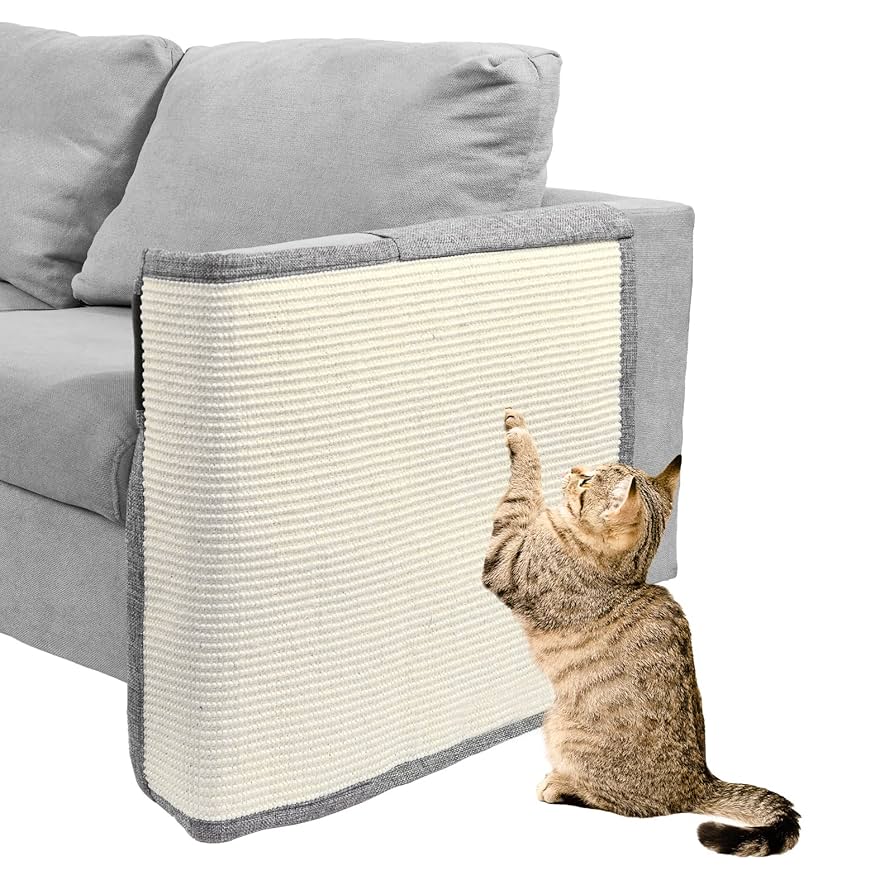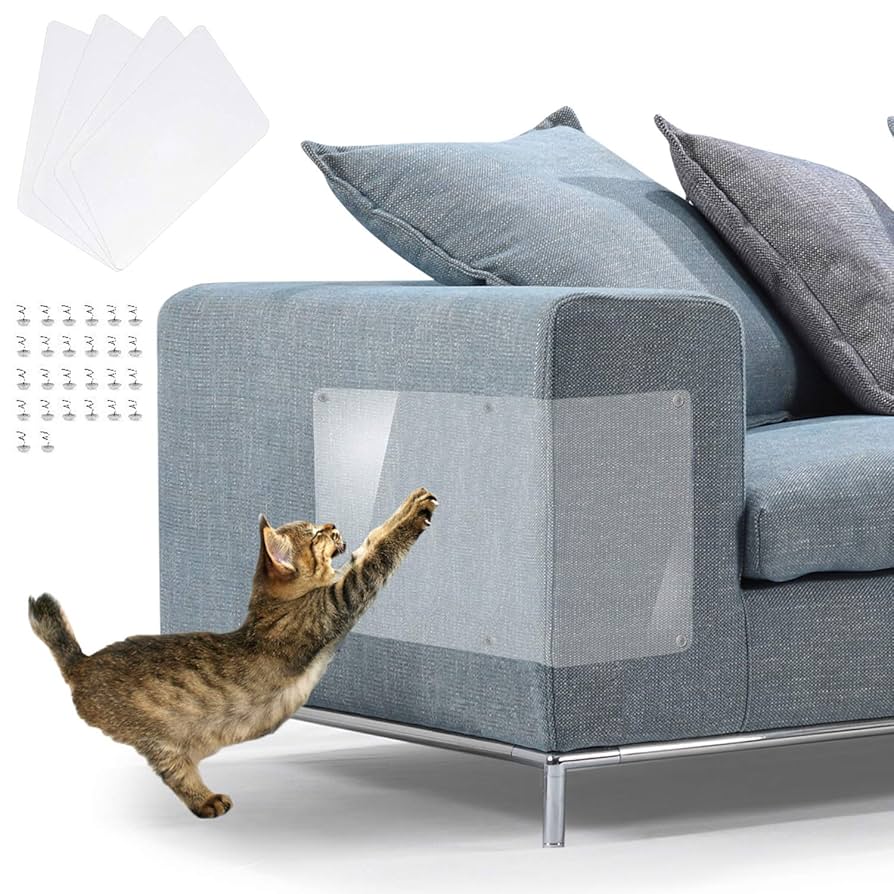Your couch is more than just furniture; it’s a cozy retreat, a centerpiece of your living room, and sometimes even a reflection of your personal style. But if you’re a cat owner, you know that your beloved feline doesn’t always share your sentiment.
Those tiny claws can turn your pristine couch into a scratching post in no time, leaving you frustrated and your couch looking less than its best. You might feel like you’re constantly on edge, wondering when the next scratch will appear.
But don’t worry—there are simple and effective ways to protect your couch while keeping your cat happy and healthy. You’ll discover proven strategies that can save your furniture and your sanity. Ready to transform your living space into a scratch-free zone? Let’s dive in.

Credit: www.amazon.com
Reasons Cats Scratch Furniture
Understanding why cats scratch furniture is key to preventing it. Scratching is more than just a bad habit; it’s a behavior rooted deeply in a cat’s nature. Knowing the reasons behind this action helps you find better ways to protect your couch and keep your cat happy.
Natural Instincts
Scratching is an instinctive behavior for cats. It helps them stretch their muscles and keep their claws sharp and ready. Even if your cat has plenty of toys, this natural urge doesn’t disappear.
Have you noticed your cat stretching out fully before scratching? This isn’t just exercise; it’s a vital part of how they stay healthy and agile.
Marking Territory
Cats use scratching to mark their territory. Their paws have scent glands that leave a unique smell behind. This tells other cats, “This space belongs to me.”
Think about it: your couch is often the comfiest spot in the house, so it’s no surprise your cat wants to claim it. How can you redirect this need to a place you prefer?
Nail Maintenance
Scratching helps cats remove the old, dead outer layers of their claws. This keeps their nails clean and sharp. Without a proper outlet, they might choose your couch instead.
Providing a scratching post close to their favorite resting area can save your furniture. Have you tried placing one near your couch to see if your cat prefers it?
Stress And Boredom
Sometimes cats scratch because they feel stressed or bored. It’s a way for them to release pent-up energy or anxiety. If your cat doesn’t have enough stimulation, they may turn to your furniture for entertainment.
Do you spend time playing with your cat every day? Interactive toys or puzzle feeders can help reduce scratching caused by boredom or stress.

Credit: www.amazon.com
Choosing The Right Alternatives
Choosing the right alternatives helps redirect your cat’s scratching behavior. Providing suitable options keeps your furniture safe. It also satisfies your cat’s natural needs. Cats scratch to mark territory and stretch muscles. Offering appealing alternatives prevents damage and keeps cats happy.
Scratching Posts
Scratching posts are essential for every cat owner. They come in various heights and materials. Vertical posts allow cats to stretch fully. Posts covered with sisal rope are durable and popular. Place posts near your couch or favorite cat spots. Encourage use by rubbing catnip on the post.
Cat Trees And Pads
Cat trees combine scratching surfaces with climbing areas. They provide exercise and entertainment. Cat pads offer a flat, horizontal surface to scratch. Both help redirect scratching away from furniture. Choose sturdy cat trees with multiple levels. Pads can be placed near resting areas for easy access.
Variety Of Textures
Cats prefer different textures for scratching. Offer sisal, cardboard, carpet, and wood options. Variety keeps cats interested and engaged. Changing textures also prevent boredom. Watch your cat’s preference and supply those materials. Rotate items regularly to maintain curiosity and use.
Training Your Cat
Training your cat to stop scratching the couch takes patience and understanding. Cats scratch to mark territory, stretch muscles, and keep claws sharp. Instead of just punishing this behavior, you can guide your cat toward better habits with the right training techniques.
Positive Reinforcement
Reward your cat when it uses a scratching post or other approved surfaces. Use treats, praise, or gentle petting immediately after the desired behavior. This helps your cat connect good things with scratching in the right place.
Try to catch your cat in the act or just before it starts scratching the couch. Redirect it gently to the scratching post and reward once it uses it. Over time, your cat will learn that the post brings rewards, not the couch.
Using Deterrents
Deterrents can discourage your cat from scratching the couch without harming it. You can apply double-sided tape or use commercial sprays with scents cats dislike, such as citrus or eucalyptus. These create an unpleasant experience for the cat on the couch surface.
Place deterrents strategically on areas your cat favors. If your cat avoids these spots, it will naturally look for alternatives to scratch. Always combine deterrents with positive reinforcement to show where scratching is allowed.
Redirecting Behavior
Provide attractive alternatives near the couch to redirect your cat’s scratching. Use scratching posts or pads covered in sisal or cardboard, placed close to the couch. This makes switching easier for your cat without feeling completely restricted.
Sometimes, you can imitate scratching behavior yourself by using your hands on the post or dangling toys to catch your cat’s interest. This playful approach can turn redirection into a fun game your cat looks forward to.
Have you noticed what textures or shapes your cat prefers for scratching? Tailoring the alternatives to your cat’s liking can speed up training and save your couch from damage.
Protecting Your Couch
Protecting your couch is key to keeping your furniture safe from cat scratches. Cats naturally scratch to mark territory and keep their claws healthy. This behavior can damage your couch fabric or leather quickly. Taking simple steps helps shield your couch and keeps your cat happy.
Furniture Covers
Use furniture covers to guard your couch from claw marks. Covers come in many materials like fabric, plastic, or quilted cotton. They are easy to clean and replace. Choose a cover that fits your couch snugly to prevent slipping. Covers also protect against dirt and spills.
Double-sided Tape
Cats dislike sticky textures under their paws. Applying double-sided tape on couch edges deters scratching. The tape feels unpleasant to cats, so they avoid those spots. Replace the tape regularly to keep it sticky and effective. This method is safe and chemical-free.
Sprays And Repellents
Sprays with scents cats dislike help keep them away from your couch. Use sprays made for pets to avoid harm. Apply the spray on areas where cats usually scratch. Test a small area first to ensure the fabric won’t stain. Repeat application often for best results.
Maintaining Your Cat’s Nails
Maintaining your cat’s nails is a key step in protecting your couch from scratches. Sharp nails can easily tear fabric, but well-kept claws reduce damage and keep your cat comfortable. Taking care of your cat’s nails also prevents painful overgrowth and health issues.
Regular Trimming
Trimming your cat’s nails regularly keeps them short and less sharp. Aim to check and trim every 1-2 weeks depending on how fast your cat’s nails grow. Use a proper cat nail clipper and avoid cutting too close to the quick, which causes pain and bleeding.
If your cat resists, try calming techniques like gentle petting or offering treats before and after trimming. This makes the process easier over time. Have you noticed how calmer cats are more cooperative during nail care?
Soft Nail Caps
Soft nail caps are small plastic covers glued onto your cat’s claws. They prevent scratching damage without harming your cat or restricting movement. These caps usually last 4-6 weeks and need reapplication as nails grow out.
Many cat owners find these caps a great alternative to trimming alone, especially for cats that scratch furniture obsessively. Would you consider using nail caps to protect your couch without stressing your cat?
Professional Grooming
Professional groomers can trim your cat’s nails safely and efficiently. They have experience handling nervous cats and can spot any nail or paw issues you might miss. Regular visits to a groomer can keep your cat’s nails in top shape.
If you’ve struggled with nail care at home, a groomer might be the solution to protect your furniture and keep your cat comfortable. Have you tried professional grooming for your cat’s nail care yet?

Credit: www.amazon.com
Creating A Stimulating Environment
Creating a stimulating environment is key to stopping cats from scratching couches. Cats need mental and physical activities to stay happy. Bored cats often scratch furniture out of frustration or to pass time. Providing fun and engaging options helps redirect their energy. This keeps your couch safe and your cat content.
Interactive Toys
Interactive toys grab a cat’s attention and keep them busy. Toys that move or make sounds encourage chasing and pouncing. Puzzle feeders make cats work for their food, which keeps their minds active. Rotate toys regularly to keep the cat interested. This stops boredom and reduces unwanted scratching.
Playtime Routine
Set regular times for playing with your cat every day. Use toys like feather wands or laser pointers to engage them. Short, frequent play sessions work best to burn off energy. Playtime helps cats release energy in a healthy way. A tired cat is less likely to scratch the couch.
Comfort And Rest Areas
Provide cozy spots for your cat to rest and relax. Soft beds or blankets in quiet areas offer comfort. Cats scratch to mark territory and feel safe. Giving them their own space reduces the need to scratch furniture. Place scratching posts near these spots to protect your couch.
Frequently Asked Questions
How Can I Stop My Cat From Scratching The Couch?
Provide a scratching post near the couch. Use cat deterrent sprays on the furniture. Trim your cat’s nails regularly. Reward your cat for using the scratching post to encourage good behavior.
What Materials Discourage Cats From Scratching Furniture?
Cats dislike rough, sticky, or slippery textures. Use double-sided tape or aluminum foil on couch areas. These surfaces make scratching uncomfortable and deter cats effectively without harming them.
Are There Safe Sprays To Protect My Couch From Scratching?
Yes, commercial cat deterrent sprays are safe. They emit scents cats dislike but are odorless to humans. Apply spray on couch edges to discourage scratching without causing harm.
Can Trimming My Cat’s Nails Reduce Couch Damage?
Yes, regular nail trimming minimizes damage. Shorter nails cause less harm when cats scratch. Trim nails every few weeks for best results and use proper tools for safety.
Conclusion
Preventing your cat from scratching the couch takes patience and care. Provide scratching posts near the couch to offer a better option. Use covers or protectors on furniture to reduce damage. Reward your cat when it uses the right spot.
Consistency is key to changing your cat’s habits. Small steps lead to a happy home for both. Keep trying different methods until you find what works best. Your couch will stay safe, and your cat will stay happy.

